Lysimachia L. (Primulaceae)
As circumscribed below, Lysimachia is represented by fourteen species in North Carolina. Lysimachia asperulifolia is currently federally listed (E). Lysimachia fraseri is currently state listed. Lysimachia hybrida and L. tonsa of conservation concern and tracked by NHP (as members of Steironema).
Federally listed taxon—
Lysimachia asperulifolia (Fed E, State E | S3 G3)
Habitat. Ecotones between longleaf pine savannas and pond pine pocosins.
Range. Endemic to the Carolinas.
Additional resources. NHP | Recovery plan | 5-yr review
Key to Lysimachia in North Carolina
Key adapted from Weakley (2008 and 2015). Photos by Krings, unless otherwise indicated. Line drawings from Britton & Brown (1913), except L. fraseri (from Patrick et al. 1995). Maps courtesy of USDA PLANTS and the North Carolina Natural Heritage Program.
1. Leaves alternate; flowers white, in a terminal raceme, the tip often lax...L. clethroides 
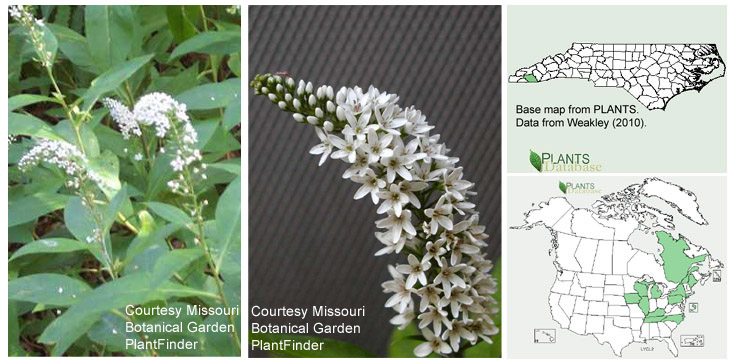 Lysimachia clethroides
Lysimachia clethroides
(rare; exotic; Mt)
1'. Leaves opposite or whorled; flowers yellow, borne variously...2.
2. Leaves nearly round; plant trailing, rooting at nodes...L. nummularia 
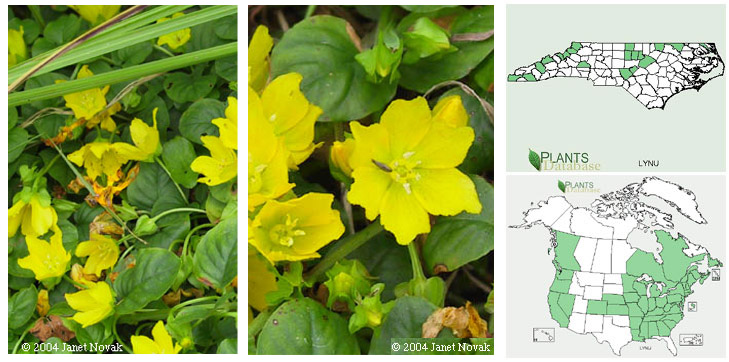

Habit of Lysimachia nummularia (Photo: Krings)

Habit of Lysimachia nummularia (Photo: Krings)

Leaves of Lysimachia nummularia (Photo: Krings)

Leaf of Lysimachia nummularia (Photo: Krings)

Flower of Lysimachia nummularia (Photo: Krings)

Flower of Lysimachia nummularia (Photo: Krings)

Flower of Lysimachia nummularia (Photo: Krings)
Lysimachia nummularia
(common; exotic; moist, disturbed areas, lawns, pastures; Mt, Pd, CP)
2'. Leaves linear, lanceolate, elliptic, or ovate; plant erect...3.
3. Flowers in a terminal raceme or panicle, subtended by bracts much smaller than the stem leaves...4.
4. Inflorescence a terminal panicle...L. fraseri 


Habit of Lysimachia fraseri (Photo: Krings)

Leaf of Lysimachia fraseri (Photo: Krings)

Abaxial leaf surface of Lysimachia fraseri (Photo: Krings)

Inflorescence of Lysimachia fraseri (Photo: Krings)

Inflorescence of Lysimachia fraseri (Photo: Krings)

Calyx of Lysimachia fraseri (Photo: Krings)

Flower of Lysimachia fraseri (Photo: Krings)
Lysimachia fraseri
(rare [State E, S3 G3]; hardwood forests, openings, and edges; Mt)
4'. Inflorescence a terminal raceme...5.
5. Leaves narrowly ovate, broadest near the base, with 3 prominent veins...L. asperulifolia* 
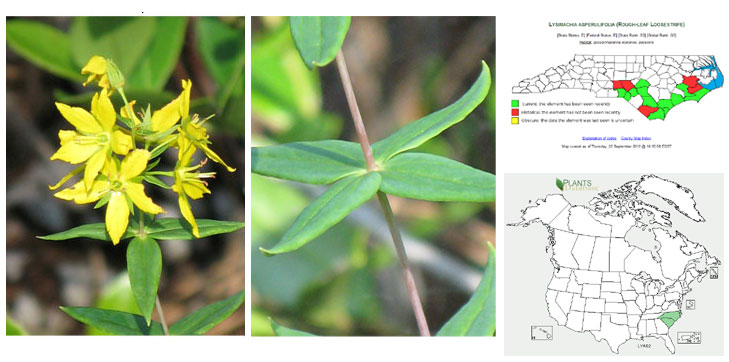

Habitat Lysimachia asperulifolia (Photo: Krings)

Habit of Lysimachia asperulifolia (Photo: Krings)

Habit of Lysimachia asperulifolia (Photo: Krings)

Lysimachia asperulifolia(Photo: Krings)

Lysimachia asperulifolia (Photo: Krings)

Raceme of Lysimachia asperulifolia (Photo: Krings)

Lysimachia asperulifolia* (Photo: Krings)
Lysimachia asperulifolia
(rare [Fed E, S3 G3]; pocosins, savanna-pocosin ecotones, sandhill-pocosin ecotones; Pd, CP, summer to early fall)
5'. Leaves linear to lanceolate, broadest near the middle, with 1 prominent vein...6.
6. Leaves linear to narrowly lanceolate, (1–) 2–4 (–8) mm wide; sepals stipitate-glandular...L. loomisii 
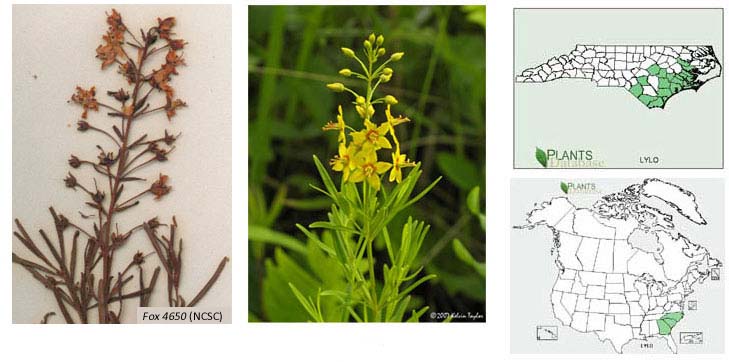 Lysimachia loomisii
Lysimachia loomisii
(uncommon; pocosin ecotones, savannas; CP)
6'. Leaves lanceolate to elliptic, 7–20 mm wide; sepals glabrous...7.
7. Flowers in part (the lower) in the axils of well-developed leaves...L. × producta [quadrifolia x terrestris] 
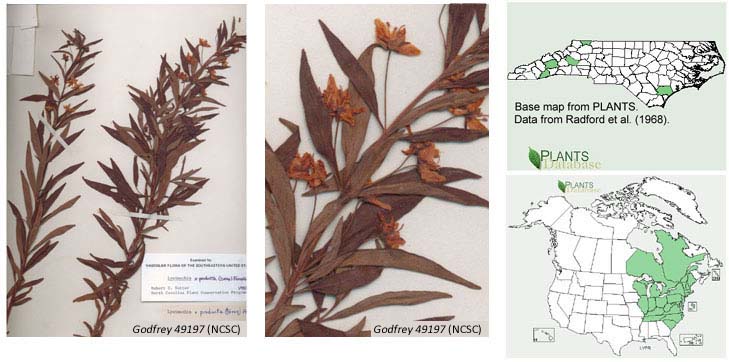 Lysimachia × producta [quadrifolia x terrestris]
Lysimachia × producta [quadrifolia x terrestris]
(rare; moist areas; Mt, CP)
7'. Flowers all in the axils of much reduced linear bracts...L. terrestris 
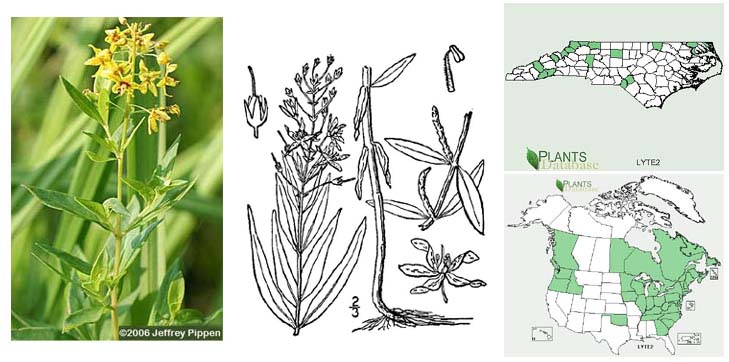 Lysimachia terrestris
Lysimachia terrestris
(uncommon; bogs, wet meadows, swamp forests; Mt, Pd, CP)
3'. Flowers axillary, all or most of them subtended by leaves similar in shape to (though often somewhat smaller than) stem leaves not subtending flowers...8.
8. Stem leaves whorled (in adult plants); leaves lineate (with sinuous, elongate markings)...9.
9. Petals yellow, marked with black lines; sepals 2.5–5 mm long...L. quadrifolia 
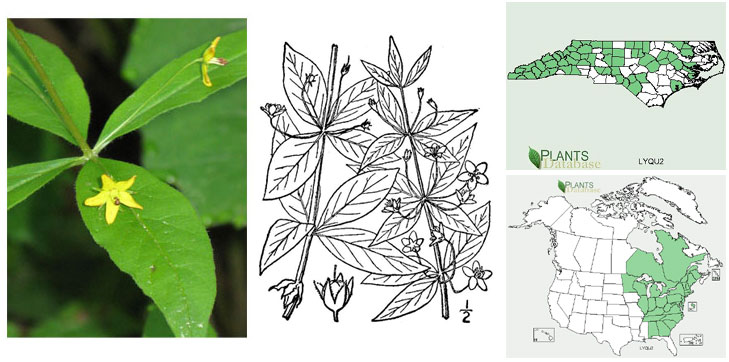

Habit of Lysimachia quadrifolia (Photo: Krings)

Leaf and stem of Lysimachia quadrifolia (Photo: Krings)

Closeup of Lysimachia quadrifolia leaf (Photo: Krings)

Lysimachia quadrifolia (Photo: Krings)

Closeup of Lysimachia quadrifolia flower (Photo: Krings)

Lysimachia quadrifolia (Photo: Krings)

Lysimachia quadrifolia (Photo: Krings)
Lysimachia quadrifolia
(common; moist to dry forests; Mt, Pd, CP)
9’. Petals plain yellow, not marked with black lines; sepals 5.5–9 mm long...L. punctata 
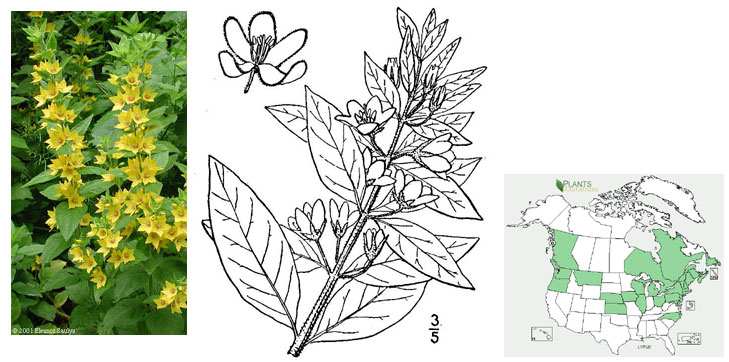 Lysimachia punctata
Lysimachia punctata
(rare; exotic; disturbed areas; Mt)
8'. Stem leaves opposite; leaves not lineate...10.
10. Mid-cauline leaves with petioles ciliate their entire length...11.
11. Mid-cauline leaves ovate to lanceolate, 17–60 mm wide...L. ciliata 
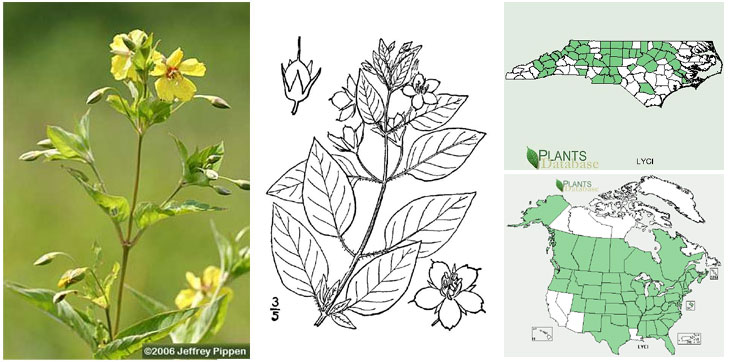

Habit of Lysimachia ciliata (Photo: Krings)

Pubescent petiole of Lysimachia ciliata (Photo: Krings)

Pubescent petiole of Lysimachia ciliata (Photo: Krings)

Leaves of Lysimachia ciliata (Photo: Krings)

Axillary flowers of Lysimachia ciliata (Photo: Krings)

Calyx and petal abaxial surface of Lysimachia ciliata (Photo: Krings)

Detail of corolla of Lysimachia ciliata, showing glands at base of petals (Photo: Krings)
Lysimachia ciliata
(common; mesic forests; Mt, Pd, CP)
11'. Mid-cauline leaves lanceolate to linear, 4–23 mm wide...12.
12. Plants lacking creeping rhizomes, but stem bases often with adventitious roots (and slightly swollen); leaf blade bases rounded to broadly cuneate; wetlands...L. hybrida 
 Lysimachia hybrida
Lysimachia hybrida
(rare [State SR-P, S2? G5]; mesic forests, wet areas; Mt, Pd, CP)
12’. Plants with well developed rhizomes, stems lacking adventitious roots; leaf blade bases cuneate; usually mesic to dry sites...L. lanceolata 
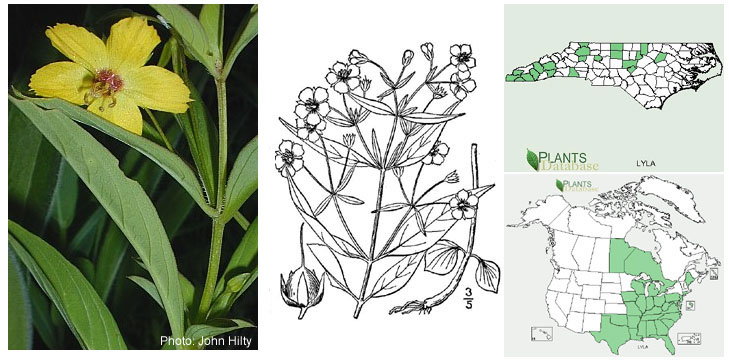

Lysimachia lanceolata (Photo: Krings)

Lysimachia lanceolata (Photo: Krings)

Lysimachia lanceolata (Photo: Krings)

Lysimachia lanceolata (Photo: Krings)

Lysimachia lanceolata (Photo: Krings)

Lysimachia lanceolata (Photo: Krings)

Lysimachia lanceolata (Photo: Krings)
Lysimachia lanceolata
(uncommon; dry to mesic forests and edges, roadsides; Mt, Pd, CP)
10'. Mid-cauline leaves with petioles pubescent only along basal portion...13.
13. Rhizomes absent, new shoots arising from crown of rootstock...L. tonsa 
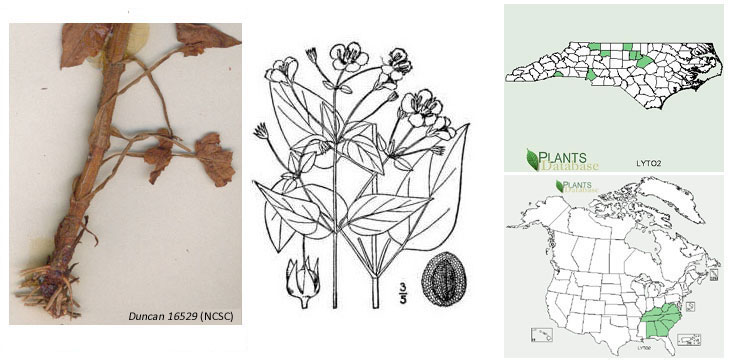 Lysimachia tonsa
Lysimachia tonsa
(rare [State SR-P, S2 G4]; upland forests over calcareous or mafic substrate; Pd)
13'. Rhizomes present, new shoots arising from the rhizome...14.
14. Leaf blades ovate to lanceolate, typically 2–4× as long as wide, rounded to cuneate at the base, with the midrib not prominent; sepals conspicuously veined, 0.5–4 mm wide...L. hybrida 
 Lysimachia hybrida
Lysimachia hybrida
(rare [State SR-P, S2? G5]; mesic forests, wet areas; Mt, Pd, CP)
14'. Leaf blades linear to narrowly lanceolate, typically 8–14× as long as wide, cuneate to tapering at the base, with a prominent midrib; sepals not conspicuously veined, 1–2 mm wide...L. quadriflora 
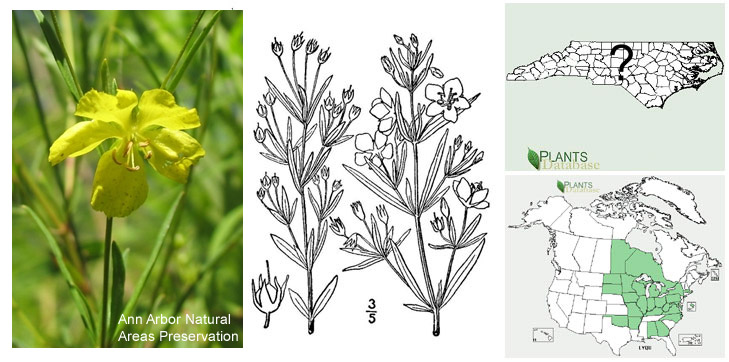 Lysimachia quadriflora
Lysimachia quadriflora
(rare; streambanks, wet meadows, and calcareous fens; Pd? [Weakley 2010 rejected the Coffey & Jones 1980 report for central NC based on the unlikely habitat and lack of documentation])















